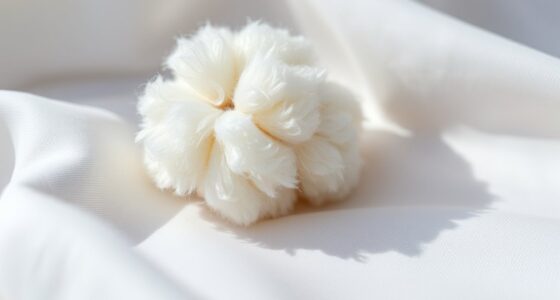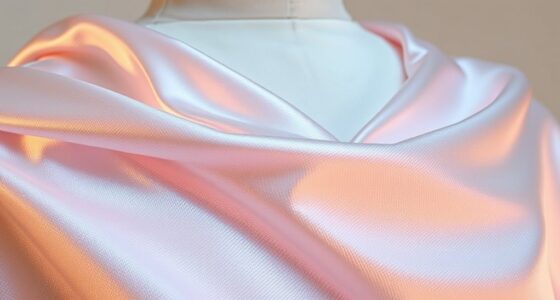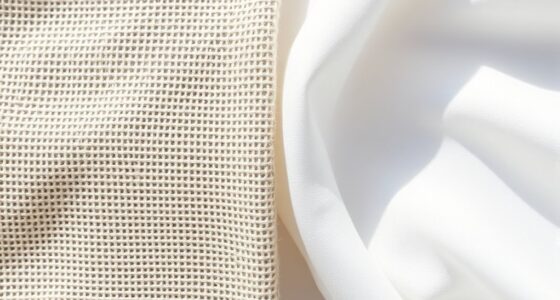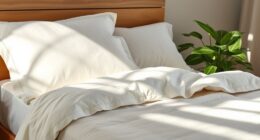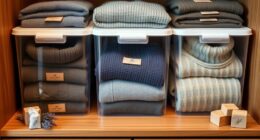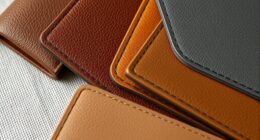When comparing rayon and viscose, you’ll find both fabrics have silky, smooth textures, but viscose usually feels softer and more luxurious. While they’re often used for similar clothing items, their environmental impacts vary; viscose process tends to be more polluting, though eco-friendly methods like lyocell are emerging. The quality of the fabric influences softness and durability—high-quality rayon can mimic viscose closely. To learn more about their differences, keep exploring this topic further.
Key Takeaways
- Viscose generally feels softer and more luxurious than rayon, which can vary in texture based on quality.
- Both fibers are made from regenerated cellulose, but viscose often has a smoother, more refined finish.
- Eco-friendly rayon options like lyocell use sustainable solvents, whereas viscose production has higher environmental concerns.
- The environmental impact of both depends on manufacturing practices; responsible methods can reduce pollution.
- High-quality rayon can mimic viscose’s softness, but viscose is typically considered more luxurious in feel.
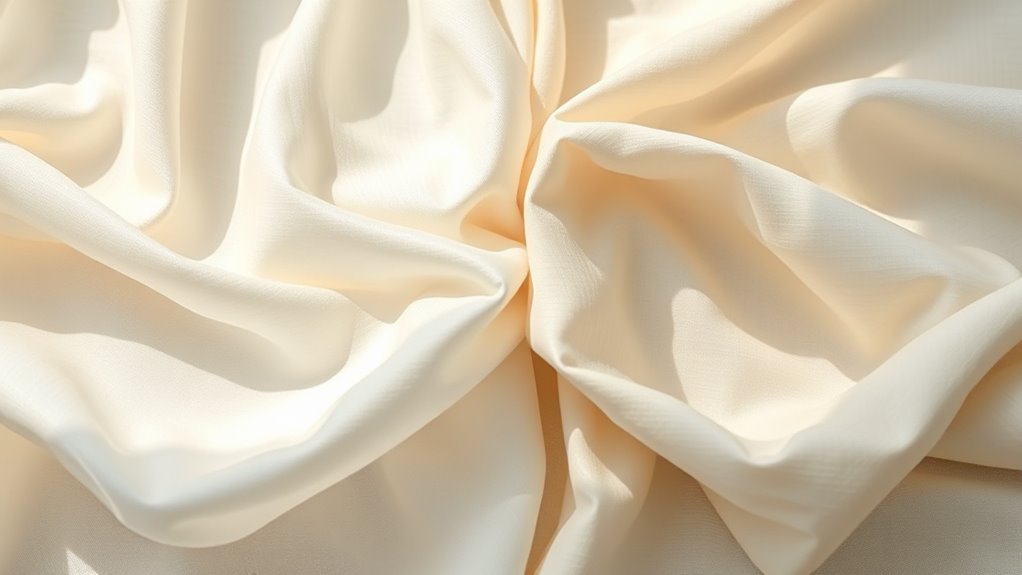
Fabric softness is one of the primary considerations. Both rayon and viscose are known for their silky, smooth texture, making them popular choices for garments like blouses, dresses, and linings. But viscose tends to be slightly softer and more luxurious to the touch. That’s because viscose is processed with a focus on achieving a high degree of fiber smoothness, resulting in a fabric that drapes beautifully and feels gentle against your skin. Rayon, on the other hand, can sometimes feel a bit stiffer or rougher, especially if it’s of lower quality or has not been properly processed. Still, high-quality rayon can mimic viscose’s softness quite closely, so your experience often depends on the specific fabric and manufacturing standards. Additionally, the quality of the fiber can greatly influence the overall feel and durability of the fabric.
When it comes to environmental impact, the differences become more significant. Both rayon and viscose involve chemical processes that can pose environmental challenges if not managed responsibly. During production, chemicals like carbon disulfide are used to break down the cellulose fibers, and improper disposal can lead to pollution. However, viscose production has historically been associated with higher environmental concerns because of the chemicals involved. Today, some manufacturers are adopting more eco-friendly practices, such as closed-loop systems that recycle chemicals and reduce waste. Rayon production varies depending on the process used; for example, lyocell, a type of rayon, uses a more sustainable solvent called N-methylmorpholine N-oxide, making it a greener alternative. Even so, both fibers can have a notable environmental footprint compared to natural fibers like cotton or hemp, especially if produced irresponsibly. Recognizing the environmental impact of these fibers can guide consumers toward more sustainable choices.
Frequently Asked Questions
How Eco-Friendly Are Rayon and Viscose Production Processes?
Rayon and viscose production have moderate environmental impacts due to chemical usage and pollution. You should know that these processes often involve toxic chemicals like carbon disulfide, which can harm ecosystems if not managed properly. While they’re biodegradable, their environmental footprint depends on manufacturing practices. Opting for brands that use eco-friendly methods can reduce your impact, making your choices more sustainable and environmentally responsible.
Can Rayon or Viscose Be Blended With Other Fibers Effectively?
You can definitely blend rayon or viscose with other fibers to enhance fabric versatility. This fiber blending improves durability, texture, and appearance, making your fabrics more functional and stylish. When you mix these fibers with cotton, polyester, or silk, you get a versatile material suitable for various garments and textiles. Just confirm proper compatibility to maintain quality, and you’ll enjoy the benefits of creative, high-quality fabric options.
Which One Is More Suitable for Allergy-Prone Skin?
You’ll find that viscose is more suitable for allergy-prone skin due to its hypoallergenic properties. It tends to cause less irritation, making it a better choice for those with skin sensitivity. Rayon, on the other hand, can sometimes trigger reactions because of chemical treatments used in production. If you have sensitive skin or allergies, opt for viscose to reduce the risk of irritation and enjoy comfortable, breathable clothing.
How Do Care Instructions Differ Between Rayon and Viscose Garments?
You should follow specific care instructions for rayon and viscose garments to preserve their fabric durability and dye retention. Both fabrics require gentle washing, preferably by hand or on a delicate cycle, and should be air-dried to prevent shrinkage. Avoid high heat during ironing, as it can weaken fibers and cause color fading. Proper care guarantees your clothes stay vibrant and durable over time.
Are There Significant Cost Differences Between Rayon and Viscose Fabrics?
You’ll find that viscose generally costs less than rayon because of lower manufacturing expenses, with price differences often around 10-20%. Imagine saving a few dollars on each yard—these savings add up for bulk purchases. The price comparison reflects manufacturing costs: viscose’s simpler process keeps it more affordable, while rayon’s additional treatments can make it pricier. So, if budget matters, viscose might be your better option.
Conclusion
So, now that you know the differences between rayon and viscose, you might wonder which one suits your needs better. Both fabrics offer softness and versatility, but their production processes and environmental impacts vary. Will you choose the budget-friendly option or prioritize sustainability? Ultimately, understanding these differences helps you make an informed decision. After all, isn’t knowing what goes into your clothes the first step toward making smarter choices?



